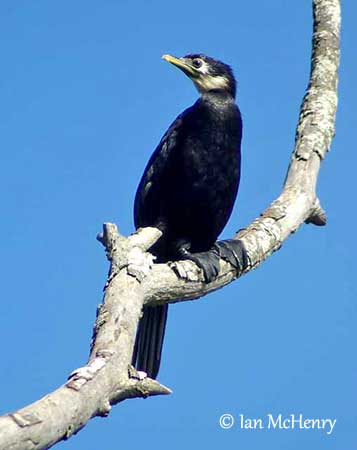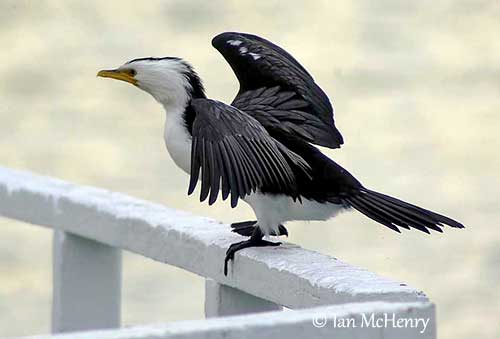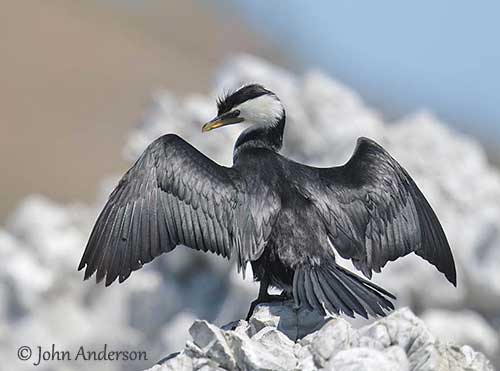
Fr: Cormoran pie
Ang: Little Pied Cormorant
All: Kräuselscharbe
Esp: Cormorán Piquicorto
Ita: Cormorano bianconero minore
Nd: Kleine Bonte Aalscholver
Sd: svartvit skarv
Photographers:
John Anderson
John Anderson Photo Galleries
Aurélien Audevard
OUESSANT DIGISCOPING
Jean Michel Fenerole
Photos d’Oiseaux du monde
Patrick Ingremeau
TAMANDUA
Ian McHenry
My New Zealand Birds
Text by Nicole Bouglouan
Sources:
HANDBOOK OF THE BIRDS OF THE WORLD vol 1 by Josep del Hoyo-Andrew Elliot-Jordi Sargatal - Lynx Edicions - ISBN: 8487334105
Birds of the Darwin Region De Niven McCrie, Richard Noske – Editeur: Csiro Publishing, 2015 – ISBN: 1486300359, 9781486300358 – 464 pages
New Zealand Birds Online
Atlas of Living Australia
What Bird-The ultimate Bird Guide (Mitchell Waite)
Wikipedia, the free encyclopaedia
Little Pied Cormorant
Microcarbo melanoleucos
Suliformes Order – Phalacrocoracidae Family
INTRODUCTION:
The Little Pied Cormorant, or Little Shag in New Zealand, is a common waterbird found in Australia, New Guinea, New Zealand and Indonesia, and some surrounding islands. It usually occurs on islands around the coasts and on inland waters. Three subspecies share the large range.
It feeds on small fish, eels, crustaceans, some amphibians and aquatic insects. It nests in trees or on cliff ledges, and breeds in colonies with other bird species.
The Little Pied Cormorant is widespread throughout the range, but it is affected by habitat degradation through conversion of wetlands for human developments. But currently, the species is not globally threatened.

DESCRIPTION OF THE BIRD:
Biometrics:
Length: 55-65 cm
Wingspan: 84-90 cm
Weight (nominate race): 567-963 g
Weight (race brevirostris): 413-877 g
The Little Pied Cormorant of nominate race in breeding plumage has black cap, only on top of head centre. Nape, back, wings and tail are greyish black. On the upperwings, the coverts show an olive sheen.
Face, throat and underparts are white with black upper flanks, sometimes part of thighs and undertail-coverts. The white parts may be stained orange to rufescent.
On the head, the sides are white from forehead to nape and throat.
In breeding conditions, the elongated head feathers form a loose crest on the forecrown, and the nape may appear shaggy.
The short, thick bill is orange-yellow with black culmen. The eyes are blue-grey. Legs and webbed feet are black.
There is olive-black bare skin around the eyes, on lores, gape and at base of mandible.
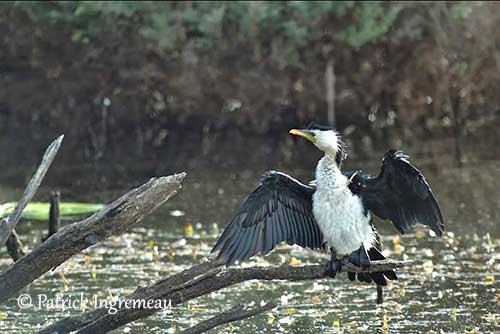
The non-breeding adult has shorter head feathers and less conspicuous crest.
The bill is mostly yellow (not orange-yellow) and the bare facial skin is yellow too.
Male and female are similar but the male is slightly larger.
The juvenile has paler head cap extending below the eye. On the forecrown, we can see a draft crest. Flight-feathers and rectrices are pointed. The dark areas of the body plumage are brown rather than black. The white areas are duller and may appear brownish-white.
The facial skin is yellowish and the lores are blackish. The bill is flesh-coloured first with dark spot near the tip. It becomes later similar to that of the non-breeding adult.
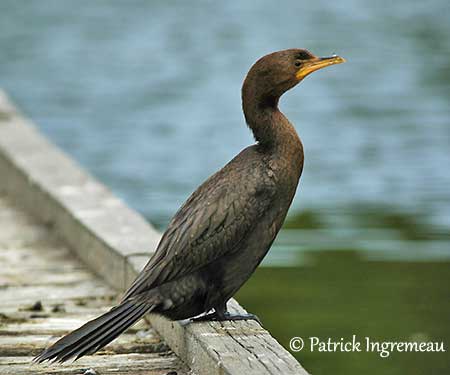
SUBSPECIES AND RANGE:
The Little Pied Cormorant has three subspecies that differ in size.
M.m. melanoleucos (described above) is found in Wallacea, E to lowland New Guinea and surroundings, Solomon Islands (except Rennell) and New Caledonia, Australia and Tasmania. Non-breeding birds are recorded in Java and Bali.
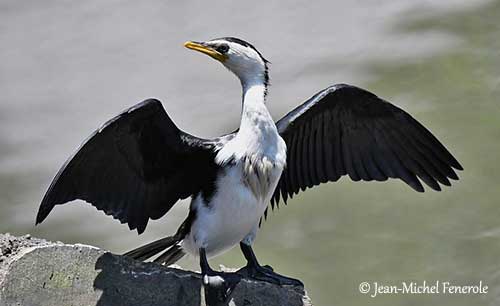
M.m. brevicauda is found on Rennell Island in S Solomon.
This race resembles nominate with some variations in plumage pattern.
M.m. brevirostris (Little Shag) is found in New Zealand, including Stewart Island. It is regularly seen on subantarctic islands and it has bred on Campbell Island.
This race is polymorphic.
Most adults are black, with white cheeks and throat, although depending on the location. Some adults have white underparts, making them very similar to the nominate race.
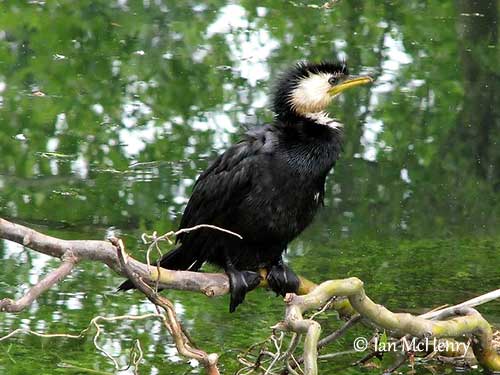
An intermediate morph (5%) shows white face and throat, and also black and white patches on breast and belly.
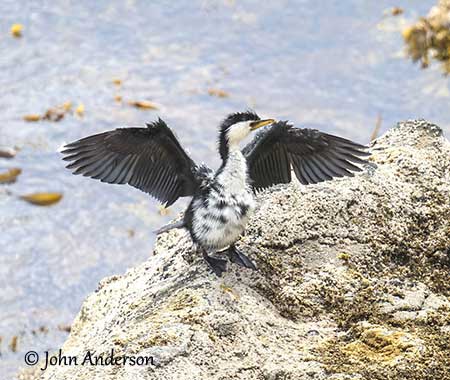
However, other individuals are all-black, similar to other small, long-tailed cormorant species. They look all-black above at any distance.
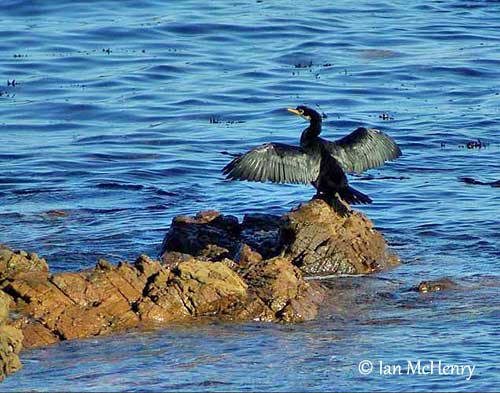
HABITAT:
The Little Pied Cormorant is usually widespread in coastal and freshwater habitats, but it favours the freshwater areas including swamps, lakes, pools, rivers, ponds and streams.
The stained plumage is acquired when the birds forage in ditches and small shallow water patches.
But the species also frequents coastal waters such as lagoons, estuaries, mangrove swamps, harbours, saltpans and offshore islands.
It needs some trees and bushes near or over water for nesting.
CALLS AND SONGS: SOUNDS BY XENO-CANTO
The Little Pied Cormorant is usually silent away from the nesting colonies.
During courtship, the male produces cooing sounds of 2-3 syllables. Both adults utter greeting calls, a series of several notes “uh…uh…uh…uh…” fading away. These calls can be heard when they approach the nest, both to bring food and to change over. The begging young give rasping calls “chree…chree…chree…”
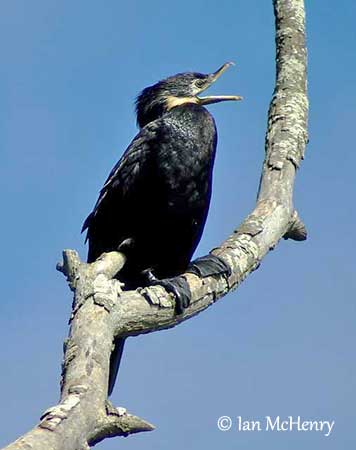
BEHAVIOUR IN THE WILD:
The Little Pied Cormorant feeds on various fish and invertebrate species. The short, slightly hooked bill is well adapted for feeding on crustaceans such as freshwater crayfish, shrimps and prawns. But it also consumes fish, amphibians (frogs and tadpoles) and aquatic insects. Crayfish are shaken off prior to consumption.
This species feeds by pursuit-diving, making a succession of shallow dives lasting about 20 seconds. It usually forages alone, occasionally in flocks, but they do not fish co-operatively.
Their feathers are not waterproof and they have to spread their wings to dry them after fishing.
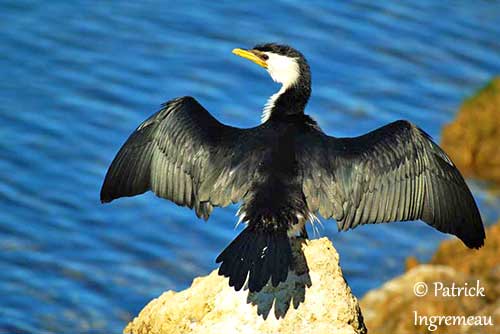
The Little Pied Cormorant breeds in colonies including other cormorant species but also Ardeidae, Anhingidae and others. The breeding period depends on water conditions and food availability.
The male calls from a chosen nest-site to attract a mate. The female is greeted by a deep bow when she lands nearby. If she accepts the male, it will gather nest material and the female will build the nest. Both adults incubate and rear the chicks.
The Little Pied Cormorant is mainly sedentary, but the juveniles perform extensive dispersal. They also move according to the local water conditions inland, and they frequently reach the coast during the droughts.
This species has strong, direct flight with powerful, rapid wingbeats.
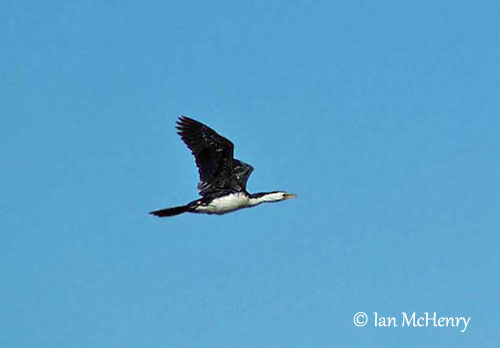
REPRODUCTION OF THIS SPECIES:
The breeding season is closely related to water levels. It could be occur all year round, with local peaks in October/November.
The Little Pied Cormorant forms small colonies, often with other species such as cormorants, herons and darters.
It nests in trees over-hanging water, occasionally on rocks or cliff ledges. In trees, the nest is built in a fork, near other nests which are about one metre apart. The nest is made with sticks and lined inside with leaves and grass.
The female lays 3-5 pale blue eggs with small brown markings. Both adults incubate during 27-28 days. At hatching, the chicks are naked with black skin, blackish bill and pink scalp and throat, but black down is growing very quickly although the scalp remains bald while the pink throat is conspicuous. They do not leave the nest until they are ready to fly. They are fed by regurgitation by both parents.
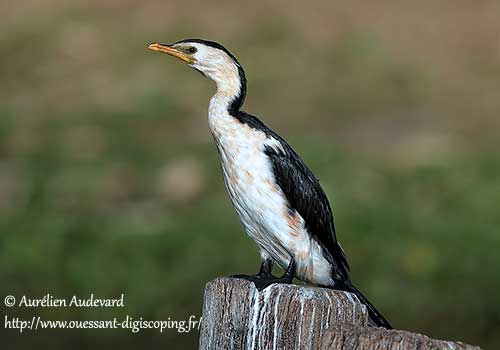
PROTECTION / THREATS / STATUS:
The Little Pied Cormorant is threatened by habitat degradation due to ecosystem alteration and degradation through conversion of wetlands for farming and human developments.
Some populations have been displaced, but the birds have adapted to other places. But the future is uncertain if habitat loss continues, involving reduction of food resources.
The population was estimated to number 36,000/201,000 individuals in 2018.
However, the species is not globally threatened and the Little Pied Cormorant is currently evaluated as Least Concern.
